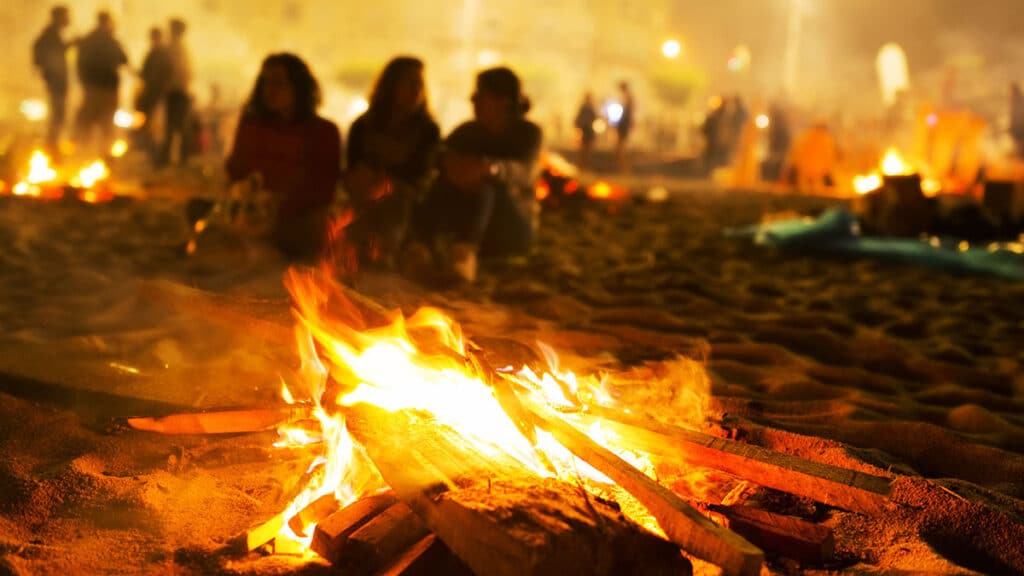
Saint John’s Eve, on the night before St John the Baptist’s traditional birthday, is a Midsummer festival in the north and a Midwinter festival in the south.
The Spanish name for the festival is “La noche de San Juan.” The Portuguese name for the festival is “Festa junina” (June Festival). Festa junina is popular in Brazil where it is midwinter.
Saint John’s Eve in New York City
The festival is not a big deal in New York City. You can’t light bonfires on the beach, except in approved fire pits. A permit may be required. Be safe. But you can jump into the water at midnight. Again be safe.
A Midsummer/Midwinter Celebration
The celebration falls near the June solstice, so it has blended with ancient European pagan celebrations of midsummer. It was originally a spring celebration, but the Catholic church encouraged the celebration on St John’s Eve.
Of course, in the southern hemisphere, St John’s Eve is a midwinter celebration.
Bonfires of St John
People in Catholic countries celebrate by gathering around bonfires with family and friends. In ancient times, people believed that evil spirits roamed free while the sun was turning south and lit bonfires for protection. When it is safe, people jump over the bonfires three times.
In Europe, the festival was originally celebrated by burning old furniture. It might be a historic inspiration for Nevada’s Burning Man Festival.
La Noche de San Juan in Spain
St John’s Eve is popular in northern Spain and along Spain’s Mediterranean coast in Catalonia and Valencia. The Catalan pastry coca de Sant Joan is popular during this time.
There is a big festival in Alicante, Valencia where the bonfire constructions have grown into elaborate sculptures called Falles. They are often built with funny, political themes.
The Festival is sort of a summer carnival where neighborhoods compete to build the most beautiful and elaborate Falles. People raise money for the floats by having paella parties. Paella is the meal Spaniards cook for large groups of people.
St John’s Eve in Portugal
The Festa de São João do Porto is a big festival in Porto, Portugal.
St John’s Eve in Brazil
The Brazilian celebration is called Festa Junina (June Festival). It is popular in northeast Brazil, the country’s traditional Portuguese region.
St John’s Eve in the United States
St John’s Eve is celebrated in New Orleans and Puerto Rico.
In New Orleans, it is celebrated as a public Voodoo festival. The tradition goes back to priestess Marie Laveau in the 1830s. New Orleans is a Caribbean culture city influenced by the Haitian Diaspora before, during and after the Haitian Revolution (1791-1804). In that time, African gatherings were banned because slavers feared uprisings, so the festival was held in secret in the swamp along Lake Ponchartrain.
Marie Laveau was able to celebrate Saint John’s Eve publicly because she was a public figure in the New Orleans community. She invited Whites. However, the public ceremony was a distraction. The actual ceremonies were held deep in the swamp at different times away from public view.
The situation continues to the present day. It’s sad because Vodou is an Indigenous faith of the Fon people of Benin in West Africa. Much of the religion is based on Central African Kongo culture. It’s similar to many human faiths around the world and across time. It’s a monotheistic faith based on nature and herbal medicine.
In competition and as a method of control, slaving colonizers and their priests demonized Indigenous and African faiths around the world. But there are no demons, only demonizers, and demonizing others actually demonizes yourself.
There is no real magic. Human ritual is theater that is designed to affect your mind. If you believe it, then it is true because it really changes your mind. But you do it to yourself, nobody does anything to you beyond the theater. That’s how it works. So if you are scared, you are actually scared of yourself (and probably what you yourself have done.)
Syncretism, the blending or masquerading of one faith inside another, is well described among African faiths of the Caribbean. But it’s also common among the Indigenous faiths of the Americas. People hid their heritage traditions inside the colonizer’s traditions to avoid punishment for celebrating their own way.
La Noche de San Juan in Puerto Rico
It used to be a popular celebration in San Juan, Puerto Rico. The original Spanish name for Puerto Rico was San Juan Bautista (St John the Baptist). Families and friends used to gather around bonfires on beaches. At midnight people would fall backwards into the sea three times to bring good luck for the coming year.
The celebration is not so common anymore. Unless you have your own group of friends, the hotels in Condado or Isla Verde are probably the best place to enjoy La Noche de San Juan in Puerto Rico.
See you on St John’s Eve!
